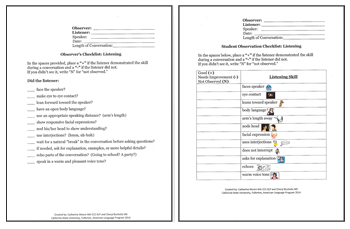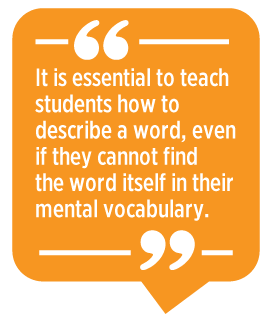|

What is the best way to learn a language? Exposure and practice! However, it is extremely difficult to gain opportunities to practice when a student does not yet have a certain level of confidence and proficiency. How can language learners get the exposure and practice that they need in order to improve and have successful conversations in English, especially when they are currently at a low proficiency level? This article offers some solutions to these challenges.
Teaching Listening
According to Brown (2001), there are seven
principles for teaching speaking skills:
- Focus on both fluency and accuracy.
- Provide intrinsically motivating techniques.
- Encourage the use of authentic
language.
- Provide appropriate feedback and
correction.
- Capitalize on the natural link between speaking
and listening.
- Give students opportunities to initiate oral
communication.
- Encourage the development of speaking
strategies.
In addition, Krisnawati (2011) further develops
upon these principles by emphasizing that in order to communicate effectively,
learners of English need to develop pragmatic competence with skills such as
speaking with appropriate intonation, expressing agreement and disagreement,
and explaining unknown words.
Students do not need to be advanced or have a high
level of vocabulary to participate in authentic conversations. This
article provides activities and descriptions that will help students at all
levels learn and practice conversation strategies.

Listening Strategies and
Activities
1. The Listening
Checklist
Every conversation starts with good listening. It
is a skill that even native speakers often lack, and each culture has its own
acceptable norms. It is essential to teach English language students the
listening standards of the culture they reside in so they can learn the skills
needed to be considered a good listener among the natives of the places they
are living. The Listening Checklist (LC; Appendix A) was created for use
in the United States with two versions for English language
learners—one version that is enhanced and simplified with visuals for
the lower levels, and another version only with text for students whose
language is more advanced (see Figure 1).

Figure 1. The Listening Checklist for more advanced (left) and lower level (right) speakers.
The LC includes a place to specify who is the
observer, listener, and speaker. In some cases, the observer may also be the
listener or the speaker. The learner engages in a conversational exchange and
writes the date and length of the conversation. The LC is then completed
looking at specific listening skills and the acceptable use of them in the
United States. Following are some of the listening skills targeted:
- proxemics (making sure the listener is not too
close or far away),
- leaning toward the speaker to show
interest,
- the use of interjections (each language has their
own that may be unique to them), and
- the use of echoing (repetition of the
speaker’s words to encourage the speaker and indicate understanding
or a need for clarification).
Each skill should be taught prior to use with the
LC. There are many ways to utilize an LC with students. Here are some ideas for
use.
-
Student Observer: Two
people engage in a conversation, and a third student acts as an observer. The
third student designates one person as a speaker, and the other as a listener,
and rates the listener on the LC once the conversation is finished.
-
Student Self-Rating:
A learner can use the LC to self-monitor after they have a conversational
exchange, assessing themselves purely as a listener.
-
Instructor
Evaluation: An instructor can complete an LC as an observer in
the classroom setting as a demonstration activity to model how to rate the
listeners. An instructor can also use the LC to monitor and assess student
listening skills while learners are in pairs with different speaking partners.
The listener of each pair can also complete the LC and compare their
self-ratings to the instructor ratings.
-
Conversational Peer
Partners: The LC can be used while students practice with
conversation partners or during informal conversational exchanges.
Conversational partners can also rate the listener on the LC, and once again,
the student can rate themselves and compare the results with their conversation
partner.
-
Homework With Digital
Media: LCs can be assigned as homework to use while watching
television, or with other similar digital or communication media, such as
YouTube. The student will choose a video, TV show, movie, YouTube clip, or something
similar and observe a conversation. They will assess the conversation
immediately after viewing. The student who is observing the digital media will
designate one of the conversational partners that they are observing as the
listener and rate their listening.
All of these possible methods of use with the LC
should lead to enhanced awareness of skills that good and bad listeners utilize
during conversational exchanges. Additionally, use of the LC should promote
increased use of successful listening skills for those making the
observations.
2. Using
“That’s...”
By using formulaic expressions combined with
intonation, English learners can express both their understanding and feelings
without needing to think about grammar and sentence structure. One way to do
this is by using “that’s” in conjunction with an
adjective (see Appendix B). If the listener understands that a situation
is negative, they can use expressions such as “that’s
awful,” “that’s sad,” and
“that’s terrible.” with a downward intonation. If
the listener understands that a situation is positive, they can use expressions
such as “that’s wonderful,”
“that’s great,” and “that’s
exciting” with an upward intonation.
Activity Steps
-
Ensure that students understand upward and
downward intonation and how they can express a positive or negative reaction.
At the top of the handout, there is a chart which not only separates various
adjectives into “positive,” “negative,”
and “neutral,” but also tells the student how to change
their tones. (Note: For the “neutral” category, an advanced
class might be able to practice with sarcasm.)
-
You and the students can brainstorm a list of
adjectives that express positive and negative reactions. If the students do not
have a high enough language ability for this, they can simply use the list
provided on the handout, and the definitions of the words can be discussed as a
class.
-
Both intonation and the newly acquired adjectives
can be combined to create a simple way to react to virtually any situation. In
order to help students practice, the bottom half of the handout includes a list
of sentences that are either negative or positive. Students would typically do
this part of the activity by working in pairs: One student will read the
sentence, and the other student will respond using
“that’s…” with an adjective and the
appropriate intonation. Then the students will switch roles.
-
Have students think about how they feel about what
their partner said. Was it a good thing or a bad thing?
3. Describing A Word
 For this activity, it is our goal to teach students
how to describe a word that they may not know or may not
remember—such a conversational “bump in the road”
often causes a conversation breakdown, which many students have difficulty
recovering from. Therefore, it is essential to teach them how to describe a
word, even if they cannot find the word itself in their mental vocabulary. The
steps for this activity (Appendix C) are twofold: For this activity, it is our goal to teach students
how to describe a word that they may not know or may not
remember—such a conversational “bump in the road”
often causes a conversation breakdown, which many students have difficulty
recovering from. Therefore, it is essential to teach them how to describe a
word, even if they cannot find the word itself in their mental vocabulary. The
steps for this activity (Appendix C) are twofold:
-
Put the Word in a
Box: All words can fit into a category; on this handout, each
category is placed in a box. This is a way for students to narrow down the idea
that they are thinking of. Many times, students say something similar to,
“I am looking for a…?,” and they pause there. It
is challenging to help a student unless they give you more information. By
putting a word “into a box,” this helps the listener know
what type of word the student is looking for. Is this word a place, a sport, an
animal, a food, a person? Each of these categories will lead to a completely
different group of words. We teach our students to categorize a word by saying,
“It is a kind of __________.”
-
Explain Similarities:
The student can explain similarities to other known items and then use any
additional knowledge that they have to further describe the word that they are
looking for. This information does not need to be grammatically correct; it can
merely be a list of facts. However, they should begin by saying, “It
is kind of like _________” in order to tell the listener what they
are doing with this language.
Example 1: “It is a
kind of sport. It is kind of like soccer, but it is in the water. They play
with their hands. There are two goals. People wear bathing suits. People have
funny hats. People yell a lot.” (Answer: Water Polo)
Example 2: “It is a
kind of animal. It is kind of like a mouse but no tail. It is very fat. It has
small ears. It can be brown, black, or white. It has a small nose. It makes a
very small noise.” (Answer: guinea pig)
Conclusion
This article provided three activities that were
created to help students at all language levels learn and practice various
conversational strategies. Additionally, these activities help students build
tactics and confidence they need to take advantage of authentic language use
and opportunities. By giving students tools and teaching them approaches that
help them compensate for and maneuver around the words, language, and grammar
that they are not comfortable with, students can still benefit from the English
conversations around them, while acquiring the language faster and more
enjoyably. These methods will help you promote communicative transformation and
increase student success by helping learners say more with less.
References
Brown, D. H. (2001). Teaching by
principles: An interactive approach to language pedagogy. Pearson.
Dale, P., & Wolf, J. (2006).Speech communication made simple (3rd ed.).
Pearson-Longman.
Krisnawati, E. (2011) Pragmatic competence in the
spoken English classroom. Indonesian Journal of Applied Linguistics,
1(1).
Miller, S. (2007). Targeting
pronunciation: Communicating clearly in English (2nd ed.). Heinle,
Cengage Learning.
Catherine Moore is a published author who enjoys teaching English language learners as well as international visiting scholars. Mrs. Moore has taught abroad and has been recognized internationally as a People to People Ambassador, and she has presented at local, state, and international conferences. In addition to teaching at North Orange County Community College District and Golden West College, she is also a current TESOL EdD candidate.
Cheryl Bucholtz-Magallon has been teaching English as a second language for 11 years in credit and noncredit programs both domestically and abroad. Ms. Bucholtz-Magallon has been an advisor for students, a mentor for future teachers, and an online instructor. She is currently teaching at Orange Coast College and Saddleback College, has a variety of experience in virtually all levels and subjects within ESL, and has presented at regional, state, and international conferences in addition to leading a teacher-training program in China.
|